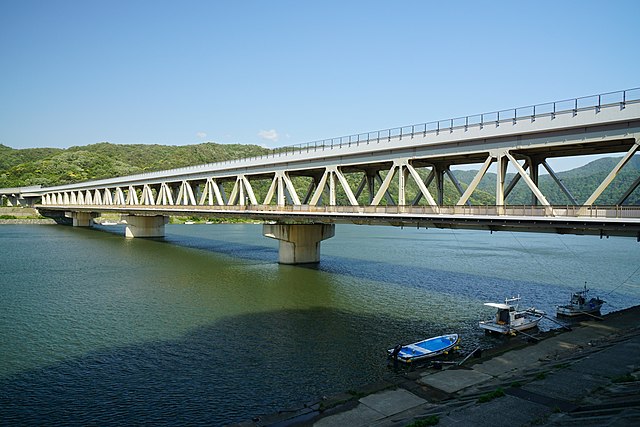Gōnokawa River
River in Hiroshima, Japan From Wikipedia, the free encyclopedia
River in Hiroshima, Japan From Wikipedia, the free encyclopedia
Seamless Wikipedia browsing. On steroids.
Every time you click a link to Wikipedia, Wiktionary or Wikiquote in your browser's search results, it will show the modern Wikiwand interface.
Wikiwand extension is a five stars, simple, with minimum permission required to keep your browsing private, safe and transparent.
The Gōnokawa River (Japanese: 江の川, Hepburn: Gōnokawa/Gōnogawa) is a river that runs through Hiroshima and Shimane prefectures in Japan. It is the largest river in the Chūgoku region. It is also called the Gōgawa River (江川) and, in Hiroshima, the Enokawa River (可愛川).[1][5]
| Gōnokawa River | |
|---|---|
 Gōnokawa River in Gōtsu Shimane Prefecture | |
 | |
| Native name | |
| Location | |
| Countries | Japan |
| Prefecture | Shimane, Hiroshima |
| Physical characteristics | |
| Source | Mount Asa (阿佐山)[1][2] |
| • location | Kitahiroshima, Hiroshima[2][3] |
| • elevation | 1,218 m (3,996 ft)[2][3] |
| Mouth | Sea of Japan |
• location | Gōtsu, Shimane[1][2] |
• coordinates | 35°01′32″N 132°13′37″E |
| Length | 194 km (121 mi)[1][2] |
| Basin size | 3,900 km2 (1,500 sq mi)[1][2][a] |
| Discharge | |
| • location | Ozekiyama (尾関山) |
| • average | 74.64 m3/s (2,636 cu ft/s)[b][4] |
| Basin features | |
| Population | 278,207[4][c] |
The mainstream originates from Mount Asa (阿佐山) located in Kitahiroshima, Hiroshima (former Geihoku). Its three tributaries including Basen River (馬洗川), Saijō River (西城川) and Kannose River (神野瀬川) flows into the mainstream in Miyoshi Basin. The gradients being relatively gentle, the river had been commonly used for boat transport until 1930s, when Sankō Line and trafficways were built and opened. There are some valleys and waterfalls such as Senjōkei, Dangyokei and Jōsei Falls around the region of the river.[1][6][7][8]
It is known for ukai (鵜飼い) or cormorant fishing for ayu, which can be found especially in Miyoshi. According to one theory ukai in Miyoshi has taken place since late Sengoku Period, and is now one of the tourist attractions of the city.[4][9][7]


The river and its tributaries pass through or borders eight cities and seven towns that are located in Shimane Prefecture and Hiroshima Prefecture as is shown below. As of 2000 according to the national census 278,207 people lived in the drainage basin, including 104,169 from Shimane and 174,038 from Hiroshima.[4]

Major dams located within the basin are shown below.